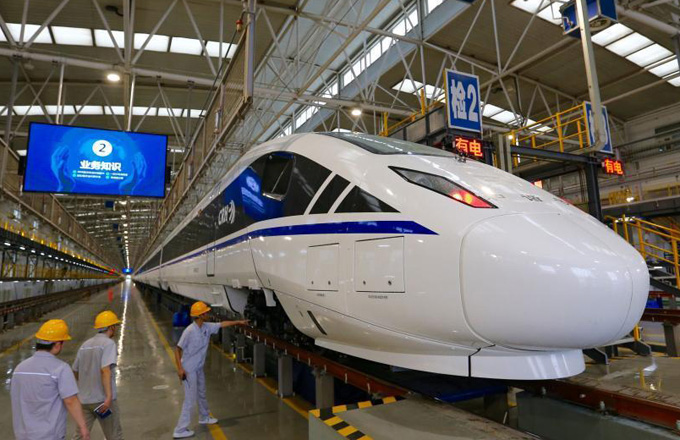New tools preserve ancient treasures
 |
|
Photo by? Shaanxi Provincial Institute of Archaelogy |
At a conference in Xi'an, archaeologists discuss how the digitalization of historical sites and relics help recreate communities, allowing them to look into the past and see the future.
But experts warn data preservation can face challenges, Cheng Yingqi reports. Being an archaeologist can be boring. Hours of digging square holes in the ground and filling out paperwork, right? That may have been true in the past, but archaeology is more than just about the past, it helps us understand the future. And today's practitioners, with computers and state-of-the-art cameras, would not consider their work boring. "Heritage is not always immortal, it can vanish, but information lasts forever," said Professor Lu Dongming at Zhejiang University. "Excavating and preserving relics is no longer the sole purpose of archaeological digs. All information should be recorded during the process. In fact, digital documentation is as important as preservation," said Lu, who specializes in applying computer technology to archaeological studies.
In the past 30 years some 40,000 cultural treasures have been lost to future generations, more than 50 percent of which destroyed by construction, China News Agency reported in June, citing the Ministry of Culture.
One attempt to use new technology to preserve vanishing sites is an ambitious plan by Dunhuang Academy to digitally recreate the Mogao Grottoes in Gansu province.
The grottoes, China's first UNESCO World Heritage Site, gained global recognition for their collection of Buddhist artworks - more than 2,000 colored sculptures and 45,000 square meters of frescoes in 735 caves carved along a cliff by worshippers.
However, climate change coupled with increasing tourist numbers has resulted in the deterioration of the frescoes, so scientists had to photograph them to make sure they were recorded.
Besides high-accuracy photography, laser 3-D scanners are used for digital recording. This process is especially valuable for stone tablets, said Ding Yao at the Tianjin University School of Architecture.
"Traditionally, we made rubbings to record information on stone tablets. However, in some cases the writing on old tablets is indistinct," he said. "But laser scanners can help us read and see all the artwork."
The digitalization of historical sites and relics is not just about data. It helps recreate the society or community at that time, allowing scientists to look into the past and see the future.
One of the most interesting examples is the Stanford Geospatial Network Model of the Roman World, a collaboration between historians and information technology specialists at Stanford University.
Based on digitalized archaeological information, the model calculates the time, expenses of people traveling through the Roman Empire.
China's first international conference on excavation documentation was held in Xi'an, capital of Shaanxi province, in May. It attracted 105 archaeologists from home and abroad. "
Since Shaanxi is very rich in buried relics and artifacts, high-tech methods applied here helped us to improve the level of archaeological documentation," said Guo Xianzeng, deputy director of the provincial cultural heritage administration. "
The archaeological community in China is experiencing explosive growth in digitalizing," he said.
However, some archaeologists and scientists worry about data sustainability, a new problem brought by the updating technology. Just because data has been recorded it does not mean it is safe.
Julian D. Richards, director of the University of York's archaeology data service in Britain, said digital data are preserved in such a vulnerable way that archaeological records are now, ironically, at greater risk than leaving the data in the ground. "
 |
|
Photo by Guillermo Munro/China Daily |
In 1986, the BBC Domesday project, including some photographs and maps, stored the data on 30-cm laserdiscs on BBC microcomputers, the safest way they could think of," he said. "By 2006 the laserdiscs were obsolete, so they had to start rescue projects for the data."
Hartmut Mueller, a co-organizer of the conference in Shaanxi and professor at Mainz University of Applied Sciences' Institute for Spatial Information and Surveying Technology, in Germany, said: "Collecting data in different systems without sufficiently considering the aspects of interoperability is the daily practice all around the globe. Not only in archaeology, but in all fields related to spatial data acquisition, processing and storage."
In Europe and elsewhere, there are many projects on how to achieve interoperability between heterogeneous systems, Mueller said.
Lu, of Zhejiang University, said that although Chinese archaeologists are applying for more digital documentation technologies, information is actually collected by different institutions, with different standards and formats.
"Information sharing could be a problem," he said.
In the past, Chinese archaeologists and scientists applied new technologies to archaeological sites without common standards, so their job was more like a "scientific experiment", which makes it difficult to standardize the data format, he said.
"While technologies become mature, it is possible for archaeologists to find a way to unify the methods for data collecting and the format of their data," Lu said.
Su Bomin, a researcher at the Conservation Institute of Dunhuang Academy, said some Chinese archaeologists are already aware of the problem of data security that comes with new technology.
"Unified management of data needs a standard, and the formulation of such a standard needs different research institutions to take part. "
As we Chinese archaeologists are already aware of these problems, I believe a standard will be completed soon," he said.
- Vice Premier calls for accelerating household registration reform
- Self-developed new train to run on high-speed rail line
- 44 dead or missing in flood-stricken Chinese county
- Hard to say goodbye: Retired foreign teacher donates living room library
- Zhejiang province elects top lawmaker, governor
























